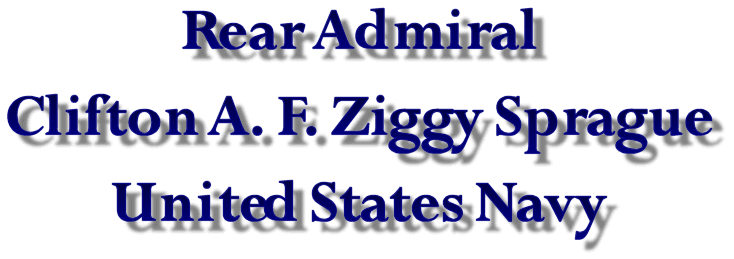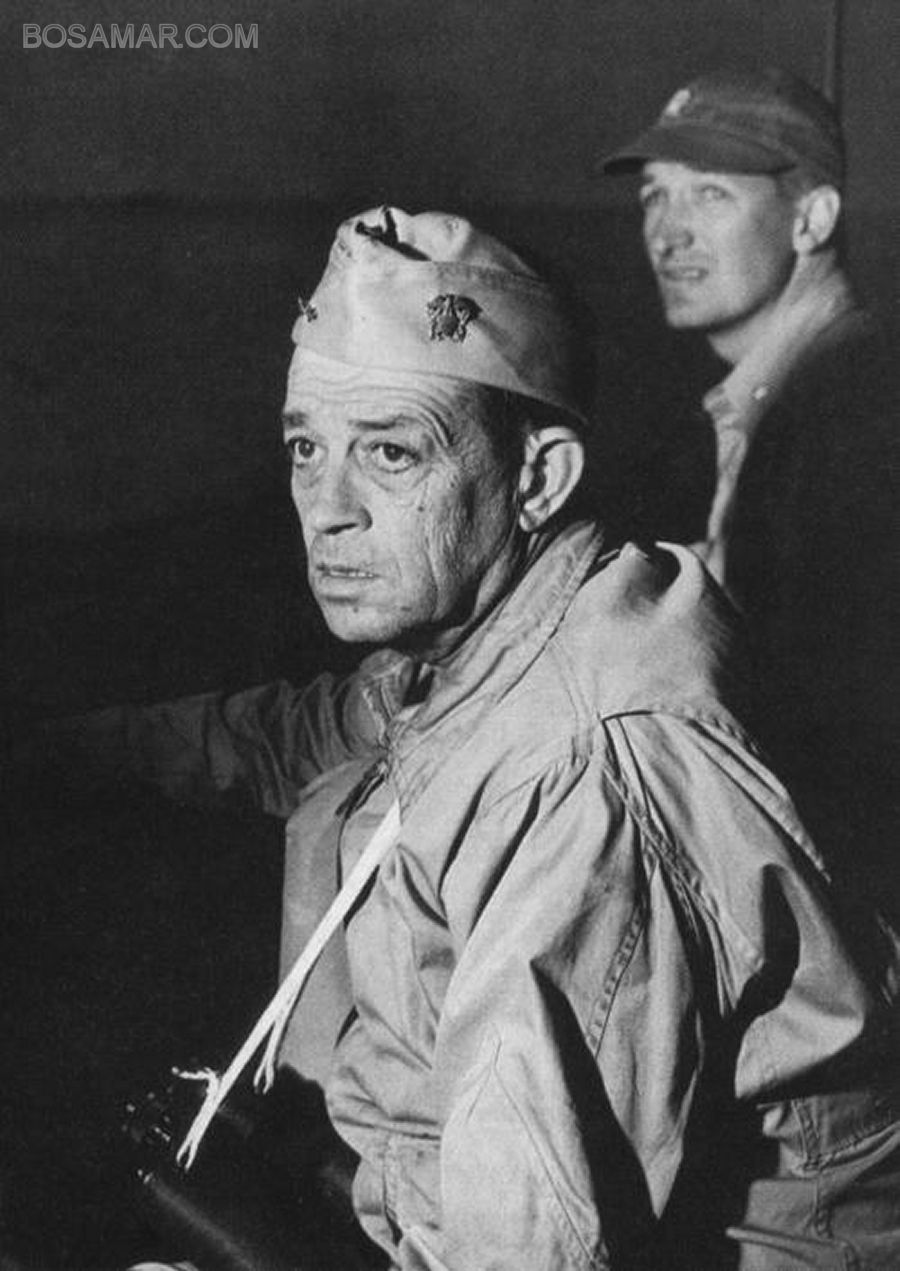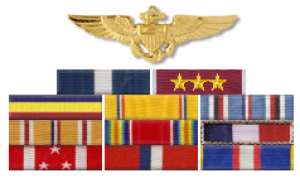
Commaner Task Unit 77.4.3 (Taffy III)
Commander Carrier Division 25

U.S. Navy photograph
Rear Admiral Sprague at Okinawa

| Navy Cross | |
| Legion of Merit (4) | |
| Combat Action Ribbon | |
| Presidential Unit Citation | |
| American Defense Service Medal | |
| American Campaign Medal | |
| Asiatic-Pacific Campaign Medal | |
| World War II Victory Medal | |
| National Defense Service Medal | |
| Philippine Presidential Unit Citation | |
| Philippine Liberation Medal | |
| Award Criteria | |
| RANK | DATES | DUTY STATION/EVENT |
| - | 1896 | Born in Dorchester, Massachusetts |
| MIDN | 1914-1917 | Student at U.S. Naval Academy Annapolis |
| ENS | 1917-1919 | USS Wheeling (PG-14) |
| LTJG | 1920 | USS Tennessee (BB-43) |
| LTJG | 1920-1922 | Student at Naval Air Station, Pensacola, Florida |
| LTJG | 1922-1923 | USS Wright (AV-1) |
| LT | 1922-1923 | Scouting Squadron VS-1 |
| LT | 1923-1926 | NAVAIRSTA/Anacostia |
| LT | 1926-1928 | USS Saratoga (CV-3) |
| LT | 1926-1928 | USS Lexington (CV-2) |
| LT | 1926-1928 | Naval Air Station, Hampton Roads, Virginia |
| LT | 1928-1929 | USS Lexington (CV-2) |
| LCDR | 1929-1931 | U.S. Naval Academy Annapolis |
| LCDR | 1931-1934 | VP-8 Fighting Tigers |
| LCDR | 1934-1936 | Naval Air Station, Norfolk, Virginia |
| LCDR | 1936-1939 | USS Yorktown (CV-5) |
| CDR | 1939 | Student at Formal Schools/Naval War College |
| CDR | 1939-1940 | USS Patoka (AO-9) |
| CDR | 1940 | Student at Formal Schools/Naval War College |
| CDR | 1940-1942 | USS Tangier (AV-8) |
| CAPT | 1942-1943 | Commander Gulf Sea Frontier |
| CAPT | 1943 | Naval Air Station, Seattle/Sandpoint, Washington |
| CAPT | 1943-1944 | USS Wasp (CV-18) |
| RADM | 1944 | COMCARDIV 25 in USS Fanshaw Bay (CVE-70) at Morotai |
| RADM | 1944 | COMCARDIV 25 in USS Fanshaw Bay (CVE-70) at Samar |
| RADM | 1945 | COMCARDIV 26 in Natoma Bay (CVE-62) at Iwo Jima |
| RADM | 1945 | COMCARDIV 26 in Makin Island (CVE-93) at Okinawa |
| RADM | 1945 | COMCARDIV 2 in USS Ticonderoga (CV-14) |
| RADM | 1945 | USS Bennington (CV-20) |
| RADM | 1946 | USS Shangri-la (CV-38) |
| RADM | 1946-1948 | Formal Schools/Primary Flight Training, NAS Corpus Cristi, TX |
| RADM | 1948 | COMCARDIV 6 in USS Kearsarge (CV-33) |
| RADM | 1949-1950 | Commander Naval Air Bases, San Diego, California/11th Naval District |
| RADM | 1950-1951 | Commander Alaskan Sea Frontier |
| VADM | 1951 | Retired and promoted to Vice Admiral |
| - | 1955 | Died of heart attack at Naval Hospital San Diego, California |
Short biography of
Vice Admiral Clifton Albert Frederick “Ziggy” Sprague, U.S. Navy
Vice Admiral Sprague was born in Dorchester, Massachusetts on January 8, 1896. He entered the U.S. Naval Academy, Annapolis, Maryland as a midshipman in June 1914 where he was given the nickname “Ziggy”. Due to the American involvement in World War 1 he received his commission as an Ensign on June 28, 1917, finishing forty-third out of 199.
His first assignment was on the gunboat USS Wheeling (PG-14) in July 1917 where he served as Gunnery Officer, Communications Officer, Navigator, and Executive Officer. Wheeling served as a convoy escort in the Atlantic and Mediterranean during the war. While assigned to Wheeling he was promoted to Lieutenant (junior Grade) and Lieutenant.
After the war in October 1919, Sprague was assigned as the reserve Commanding Officer of USS Manley (DD-74) for two months. Thereafter he was assigned to the new battleship Tennessee (BB-43) and served as 6th Broadside Battery Officer for one year.
On December 3, 1920, Lieutenant Sprague joined 33 other classmates at Naval Air Station, Pensacola, Florida as a student pilot. His first flight was on January 11, 1921 when he piloted a Curtiss N9 aircraft for twenty minutes. Sprague earned the designation Naval Aviator No. 2934 on August 11, 1921. Due to his great proficiency within two months he was designated as Commanding Officer Aircraft Squadron 3 at Pensacola.
From March 1922 to November 1923, Sprague was assigned to Aircraft Squadron VS-1 with the Atlantic Fleet based on the seaplane tender USS Wright (AV-1). He reported to his next duty station Naval Air Station, Anacostia, near Washington, DC, in November 1923 where he served as a Test Pilot, Operations Officer, and Executive Officer. As a Test Pilot he conducted experimental and research work at the Naval Aircraft Factory in Philadelphia, Pennsylvania in 1923, where he contributed to the development of aircraft carrier catapult systems. From March 1926 to February 1928 he assisted inventor Carl Norden in the laboratory and as a Test Pilot at Naval Air Station Hampton Roads, Virginia with improvements to the Mark-1 aircraft carrier arresting gear system for USS Lexington (CV-2) and USS Saratoga (CV-3).
Lieutenant Sprague reported to USS Lexington (CV-2) in March 1928 where he assumed the duties of Flight Deck Officer and Assistant Air Officer. In January 1929 Lexington along with USS Langley (CV-) and USS Saratoga (CV-3) participated in Fleet Exercise IX, a simulated aerial attack on the Panama Canal. Sprague’s tour on Lexington ended in April 1929.
Returning to the U.S. Naval Academy in May 1929 Sprague served as Executive Officer of VN-8-D5. On June 10, 1930 he was promoted to Lieutenant Commander. His tour at the Naval Academy ended in November 1931.
Lieutenant Commander Sprague served as Squadron Commander of VP-8 in Panama in December 1931 to April 1934. The squadron was based on the seaplane tender USS Wright (AV-1) homeported at the Norfolk Navy Yard. In 1933 the squadron was moved to Hawaii where Sprague became the first Navy Pilot to fly a thirteen-hour round-trip from Hawaii to Midway Island in February 1934.
From May 1934 to July 1936, Sprague served as Air Operations Officer at Naval Air Station, Norfolk, Virginia where his department serviced several aircraft carrier squadrons.
In July 1936, Lieutenant Commander Sprague was assigned to the newly constructed aircraft carrier USS Yorktown (CV-5) as Air Officer. After her commissioning, he piloted the first two landings ever made on Yorktown. In addition, he was the first pilot to test the catapult system on Yorktown. Sprague was promoted to Commander in December 1937. He spent all of 1938 managing the Air Department and aircraft squadrons on Yorktown. In February 1939 Yorktown participated in Fleet Problem XX in the Caribbean. Shortly thereafter Sprague left the carrier in June 1939.
Commander Sprague was ordered to the Naval War College in Newport, Rhode Island in June 1939 where he spent 3 months in study before reporting to his first sea command, the 21-year old oil tanker USS Patoka (AO-9) at Puget Sound Naval Shipyard, Bremerton, Washington. Sprague commanded Patoka until June 1940 when he was sent back to the Naval War College for two more months of study.
At Oakland, California Sprague took command of the cargo ship Tangier which was being converted into a sea plane tender in July 1940. USS Tangier (AV-8) was commissioned on August 25, 1941 and shortly thereafter transited to Bremerton, Washington to load torpedoes. At her homeport in Pearl Harbor, Hawaii Tangier was mated with Fleet Patrol Wing Two. Tangier was berthed at F-10 on the Northwest side of Ford Island on the morning of December 7, 1941. She was one of the first ships in the harbor to open fire and engaged several Japanese aircraft throughout the morning. Tangier was credited with downing three aircraft. As a result of his leadership at Pearl Harbor, Sprague was promoted to Captain on January 3, 1942. In early 1942 Tangier saw service at New Caledonia.
Captain Sprague was assigned as Air Officer of Gulf Sea Frontier, Miami, Florida in June 1942. His duties involved improving defenses, keeping the sea lanes open, and countering the German U-boats on the Southeast coast of the United States. Upon achieving his goals he was transferred in March 1943.
In April 1943, Sprague was transferred to Naval Air Center, Seattle, Washington where he served as Commander of the base and nearby Naval Air Station, Sand Point. This duty ended abruptly when he was assigned as the Commanding Officer of the newly constructed fast fleet carrier USS Wasp (CV-18) in October 1943.
Arriving at Bethlehem Steel Company Fore River Yard near Boston, Massachusetts, Sprague took command of Wasp (CV-18) where she was commissioned on November 24, 1943. The carrier was quickly sent to the Pacific where she joined the war against the Japanese. Her first combat missions were to destroy enemy aircraft, installations, and surface craft on Marcus and Wake Islands in May 1944. In June 1944 Wasp participated in the invasion of Saipan and the Battle of the Philippine Sea. On July 9, 1944, shortly before leaving Wasp, Sprague was promoted to Rear Admiral at age 48.
Rear Admiral Sprague was designated as Commander Carrier Division 25 on July 23, 1944 with his flag in USS Fanshaw Bay (CVE-70). In September 1944 his Task Unit supported the Morotia landing.
Rear Admiral Sprague’s greatest achievement came on October 25, 1944 when his Task Unit 77.4.3 (Taffy III) consisting of 6 escort carriers, 3 destroyers, and 4 destroyer escorts fought off the vastly superior Japanese Centre Force. The Japanese force consisted of 4 battleships, 6 heavy cruisers, 2 light cruisers, and 11 destroyers off the Island of Samar in the Philippines.
On February 19, 1945, Sprague assumed command of Carrier Division 26 embarked on USS Natoma Bay (CVE-62) for the invasion of Iwo Jima where his unit provided close air support for the Marines ashore. The next month he moved his flag back to USS Fanshaw Bay (CVE-70) for the invasion of Okinawa.
In April 1945, Sprague was given command of Carrier Division 2, a fast carrier Task Group and moved his flag to USS Ticonderoga (CV-14) on June 1, 1945. His Task Group operated against the Japanese home islands of Kyushu, Honshu, and Hokkaido. Sprague received the notification of the end of hostilities while steaming 151 miles off the eastern coast of Honshu on August 15, 1945. Four days after the Japanese surrender, Sprague and USS Ticonderoga (CV-14) entered Tokyo Bay.
Rear Admiral Sprague returned to the West Coast onboard USS Bennington (CV-20) in November 1945. He spent the next month in Washington, DC briefing Naval leaders at the White House.
In February 1946, Sprague was given command of Navy Air Group 1.6 of Joint Task Force 1 with his flag in USS Shangri-La (CV-38) at San Diego, California. During the next six months he supported the naval aviation forces in Operation Crossroads nuclear tests on Bikini Atoll in the Marshall Islands.
At Corpus Christi, Texas Sprague was assigned as Chief of Naval Air Basic Training in August 1946. In January 1948 he was redesignated as Commander, Naval Air Advanced Training. His tour ended in April 1948.
Rear Admiral Sprague’s last seagoing command was as Commander, Carrier Division 6 with his flag in USS Kearsarge (CV-33) from May to October 1948. During this tour Kearsarge operated in the Mediterranean. On January 1, 1949 to February 1950, Sprague was Commander of Naval Air Bases, Eleventh and Twelfth Naval District at Naval Air Station Coronado in San Diego, California.
Reassigned in March 1950, Sprague was moved to Alaska where he served as Commandant, Seventeenth Naval District and Commander, Alaskan Sea Frontier on Kodiak Island. It was from here that he embarked on a B-29 and became the first U.S. Navy admiral to fly over the North Pole on November 12, 1950.
On August 9, 1951, Sprague requested voluntary retirement from the Navy and was officially retired on November 1, 1951. As was custom at the time, he was advanced to Vice Admiral at retirement in recognition of his Navy Cross. He had spent 34 years, 4 months, and 4 days on active duty. In March 1955, Sprague fell ill of a weak heart and was moved to Naval Hospital, San Diego, California. On April 11, 1955, at 59 years of age he died from a massive heart attack. Two days later he was buried at Fort Rosecrans National Cemetery at Point Loma, San Diego, California.
Source: Devotion to Duty, A biography of Admiral Clifton A. F. Sprague by John F. Wukovits (1995)